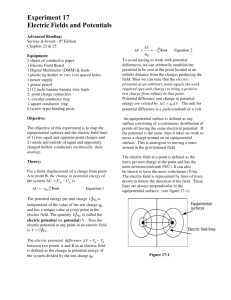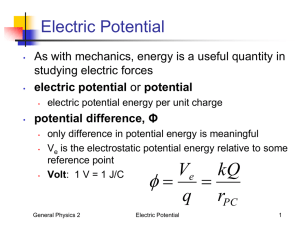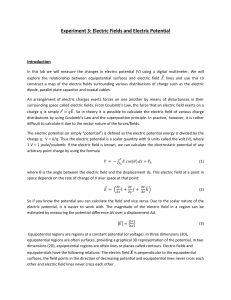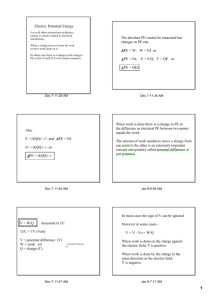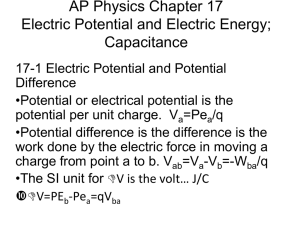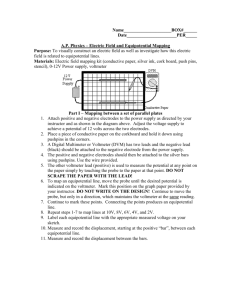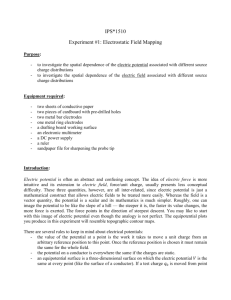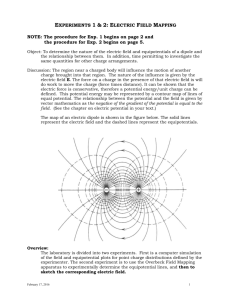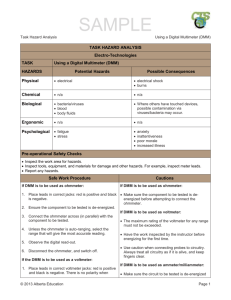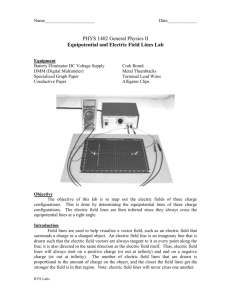Physics 215 - Experiment 8 Electric Fields and Potentials
advertisement
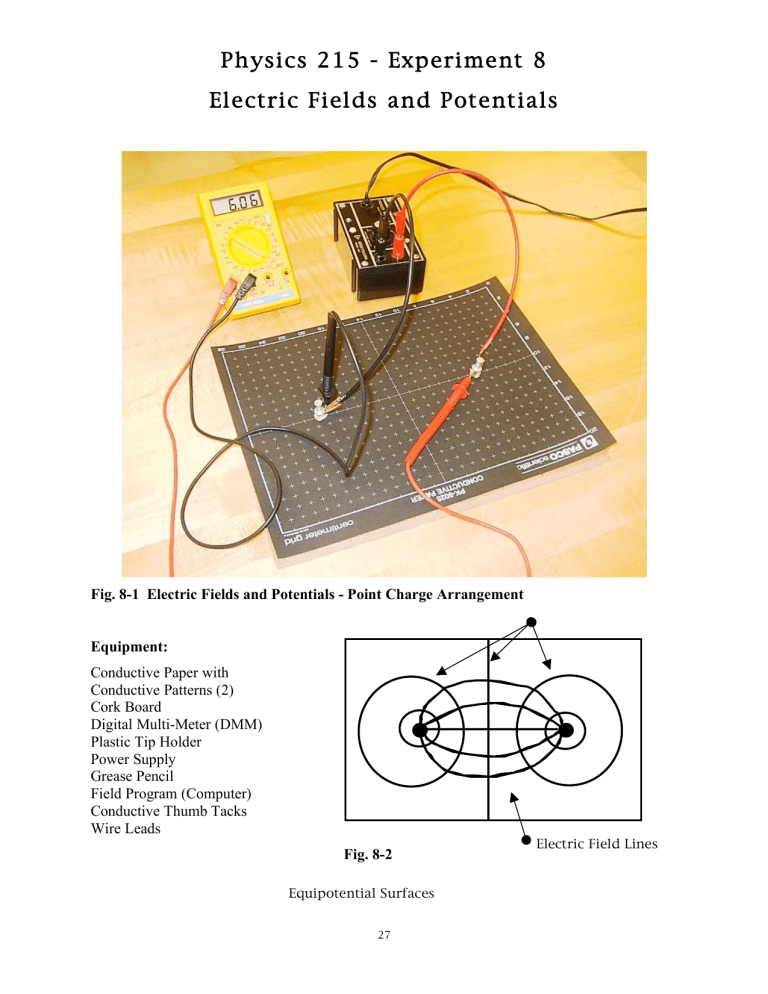
Physics 215 - Experiment 8 Electric Fields and Pot ent ials Fig. 8-1 Electric Fields and Potentials - Point Charge Arrangement Equipment: Conductive Paper with Conductive Patterns (2) Cork Board Digital Multi-Meter (DMM) Plastic Tip Holder Power Supply Grease Pencil Field Program (Computer) Conductive Thumb Tacks Wire Leads Fig. 8-2 Equipotential Surfaces 27 Electric Field Lines Physics 215 - Experiment 8 Electric Fields and Pot ent ials Advance Reading Electric field lines point in the direction of Urone, Chapter 17, sections 17-4 through 17- maximum decrease in potential. 6; Chapter 18, Sections 18.1 through 18-4. Appendix C: Equipment DMM. An equipotential surface is defined as a surface where all points on the surface have Objective: The objective of this lab is to the same electric potential. To move a map equipotential lines and field lines of charge around on such a surface requires no point charges and parallel plates. work. In two-dimensions the equipotential surfaces are equipotential lines. How close Theory: An electric field, E, at a point is the lines are to each other is an indication of defined as the force per unit charge at the the field strength. Electric field lines are point: always perpendicular to equipotential lines. E = F/q (Eq. 8-1) The two conductive patterns, point charges and parallel plates, are on The electric field is represented by lines of conductive/resistive paper. Perfectly force drawn to follow the direction of the conducting paper would have zero potential field. difference between two points. The paper tends to concentrate the electric field into The electric potential is defined as the the plane of the paper. potential energy per unit charge, however, we can only measure the difference in Procedure potential energy between two points. This Set Up and Connections change in potential energy per unit charge 1. Place the point charge pattern (two dots) (the voltage, Vba) is equal to the work done on the corkboard. Push a pin into the by the electric force to move a charge from center of each point charge. 2. one point to another: Unplug and turn off the power supply. Refer to Fig. 8-1 and 8-3: connect the Vba = Vb - Va = W/q (Eq. 8-2) power supply to the point charges. 28 Physics 215 - Experiment 8 Electric Fields and Pot ent ials Equipotential Lines: Point Charges 5. Hold the DMM ground lead on the 0.0V point charge. Watch the voltmeter as you move the positive lead across the conductive sheet. 6. Keeping the ground lead at the 0.0V point charge, find at least four equally Fig.8-3 Banana-Alligator Wire Lead spaced points where the voltmeter reads Use the banana connector on the power 1.0V. As you locate each point, press supply, alligator connector on the pins. the tip of the lead into the sheet to leave an indentation. After finding the four 3. Refer to Fig. 8-1 and Fig. C-9: connect points, "connect the dots" using the the ground lead (black) from the DMM grease pencil. Label the equipotential to the negative point charge (black line as 1.0V. 7. wire). Connect the positive lead (red) of Each lab partner should draw one set of the DMM from the "V" jack of the equipotential lines. DMM to the positive point charge (red 8. wire). 4. Repeat Step 6 for 3.0V , 4.0V & 5.0V. Place the DMM leads into the plastic tip holder and measure the potential Turn the DMM on; turn the dial to 20 on difference across the 3.0V equipotential the DCV (voltage) scale. This means the line. Calculate the field strength at this DMM (voltmeter) is configured to location in V/m. measure voltage up to 20V. Plug in the 9. power supply; increase the power until Use the grease pencil to mark the position where you measured the field the voltmeter reads 6.0V. Label the strength, then record the value on the point charges with the grease pencil (i.e., conductive paper. the ground from the power supply is at 0.0V and the positive lead from the power supply is at 6.0V). 29 Physics 215 - Experiment 8 Electric Fields and Pot ent ials Electric Field Lines - Point Charges Steps 1-4: Connect the power supply 10. Place and DMM to the parallel plate pattern. the DMM leads in the plastic tip holder. Place the ground lead as close to Set the potential difference to 6.0V. 13. Refer the 0.0V point charge as possible, just to Step 8 and Step 9. Measure the off- center of a line that would connect field strength at the geometric center of the two point charges. As you pivot the the parallel plate. positive lead around the ground lead, watch the values on the voltmeter. Equipotential Lines When you have located the position of 14. Locate the 2.0V equipotential line near maximum value, press an indentation the edge of the plate configuration (refer into the paper with the red lead. Now to Step 6). Find three more points "walk" the leads across the paper by outside the end of the parallel plate that placing the ground lead into the are at 2.0V potential. Connect the dots. 15. Your indentation you made with the positive partner repeats for 4.0V. lead. When you reach the 6.0V point charge, "connect the dots" with the Questions grease pencil. 1. Use dimensional analysis to show that 11. Your partner will repeat Step 10, the electric field unit of N/C equals V/m. beginning from a different position (Urone, Section. 18.1.) around the 0.0V point charge. Are your 2. How does Figure 18.8 in your text field lines perpendicular to the compare to the point charge sheet you equipotential lines? produced? Measuring Electric Field Strength Parallel Plates 12. Refer to Figure 18.10 in your textbook. If you repeated Steps 6-11 for the parallel plate configuration, it would be similar to this illustration. Refer to 30
